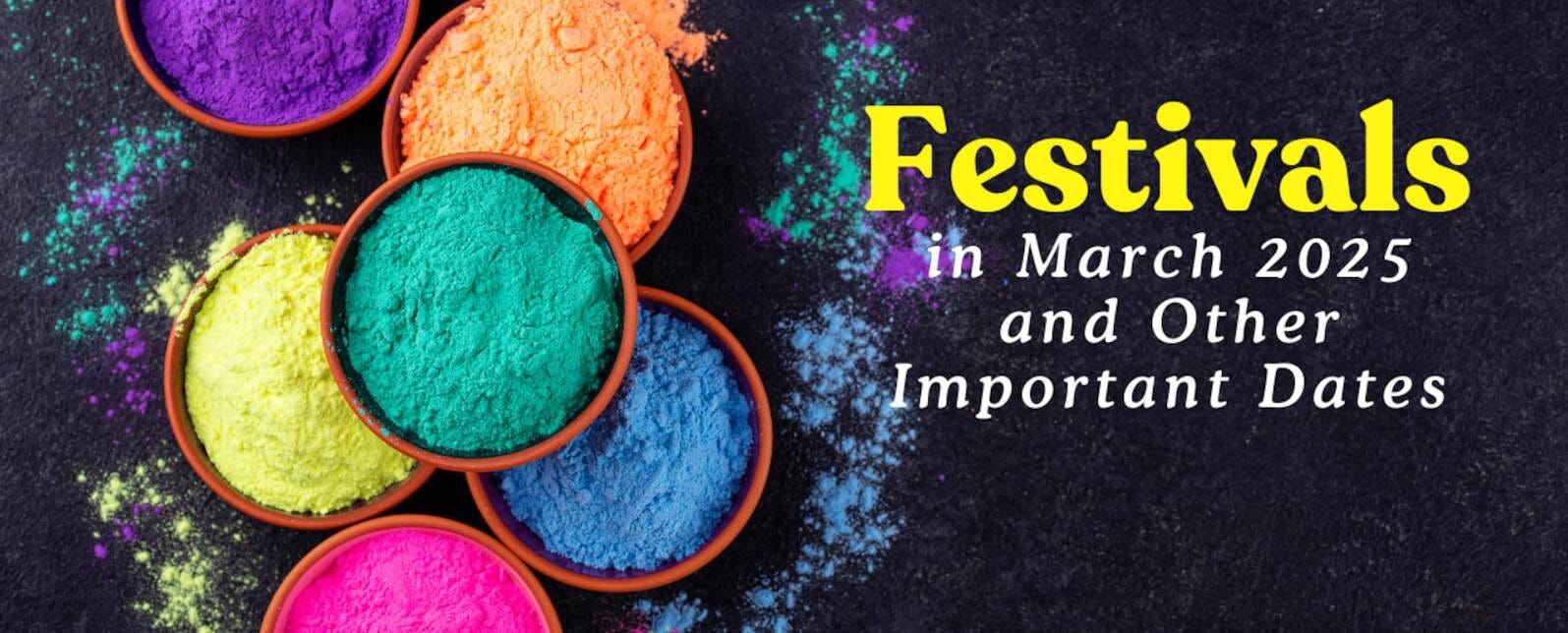March 2025 is a month rich with cultural and spiritual significance across India. It is a time when people come together to celebrate traditional festivals, observe religious fasts, and perform sacred rituals that mark the transition of seasons, honor deities, and strengthen social bonds.
From the vibrant festival of Holi to the spiritually uplifting Chaitra Navratri, this month brings a diverse range of observances rooted in India's spiritual heritage. Here is a detailed look at the most significant festivals, pujas, and rituals in March 2025.
1. Ramakrishna Jayanti (March 1, 2025)
Ramakrishna Jayanti marks the birth anniversary of Sri Ramakrishna Paramhansa, a revered spiritual leader and mystic from the 19th century. His teachings inspired the Ramakrishna Mission, which promotes spiritual awakening and social service.
Significance: Devotees remember his wisdom and spiritual teachings through prayers, bhajans, and discourses.
Where It Is Celebrated: Across India, especially in West Bengal at the Dakshineswar Kali Temple and Belur Math.
2. Holashtak Begins (March 7, 2025)
Holashtak is the eight-day period leading up to Holi and is considered inauspicious for beginning new ventures like marriages, business deals, or housewarming ceremonies.
Significance: People engage in spiritual activities, fasting, and preparing for the grand festival of Holi.
Where It Is Observed: Mostly in North India, particularly in Uttar Pradesh, Bihar, and Rajasthan.
3. Amalaki Ekadashi (March 9, 2025)
Amalaki Ekadashi is dedicated to worshipping the Amla tree (Indian gooseberry), which is considered sacred in Hinduism.
Significance: Observing this Ekadashi is believed to bring prosperity and cleanse sins.
Rituals: Devotees fast, offer prayers to Lord Vishnu, and plant or worship the Amla tree.
Where It Is Observed: Nationwide, especially in Vaishnavite temples.
4. Holika Dahan (March 13, 2025)
Also known as Chhoti Holi, this festival symbolizes the victory of good over evil. A bonfire is lit in the evening to commemorate the burning of Holika, the demoness, and the protection of Prahlad.
Significance: The bonfire represents the triumph of virtue over vice.
Rituals: People gather around the fire, chant prayers, and offer grains, coconut, and sweets.
Where It Is Celebrated: North India, particularly in Mathura, Vrindavan, Varanasi, and Ujjain.
5. Holi (March 14, 2025)
Holi is one of India’s most joyous and colorful festivals, celebrated with enthusiasm and energy.
Significance: It marks the arrival of spring and the victory of good over evil.
Rituals: People play with gulal (colored powders), splash water, and enjoy festive delicacies like gujiya, thandai, and malpua.
Where It Is Celebrated: All over India, with grand celebrations in Mathura, Barsana, Vrindavan, Delhi, and Rajasthan.
6. Bhai Dooj / Bhratri Dwitiya (March 15-16, 2025)
A festival that honors the bond between brothers and sisters. Sisters pray for their brothers' long life and well-being.
Significance: Strengthens sibling relationships.
Rituals: Sisters apply a tilak (vermilion mark) on their brothers' foreheads and exchange sweets.
Where It Is Celebrated: Predominantly in North and Central India.
7. Chhatrapati Shivaji Maharaj Jayanti (March 17, 2025)
This day commemorates the birth anniversary of Chhatrapati Shivaji Maharaj, the founder of the Maratha Empire.
Significance: A day of national pride, remembering his bravery and governance.
Rituals: Processions, patriotic programs, and speeches on his legacy.
Where It Is Celebrated: Primarily in Maharashtra.
8. Rang Panchami (March 19, 2025)
Observed in Maharashtra and Madhya Pradesh, Rang Panchami is celebrated five days after Holi with colors and water festivities.
Significance: Symbolizes the spread of positivity.
Rituals: Community gatherings, throwing colors, and playing traditional music.
Where It Is Celebrated: Indore, Pune, and Nashik.
9. Sheetala Saptami & Ashtami (March 21-22, 2025)
Dedicated to Goddess Sheetala, who is believed to prevent smallpox and infectious diseases.
Significance: Prayers are offered for health and protection.
Rituals: Devotees consume cold food prepared a day earlier.
Where It Is Celebrated: Predominantly in North India.
10. Chaitra Navratri (March 29 - April 6, 2025)
A nine-day festival dedicated to Goddess Durga, marking the Hindu New Year in many regions.
Significance: Begins the Hindu New Year in many states.
Rituals: Fasting, Durga Puja, Ramlila performances, and Kanya Puja.
Where It Is Celebrated: North India, West Bengal, Gujarat.
11. Gudi Padwa / Ugadi (March 30, 2025)
Marks the New Year for Maharashtrians (Gudi Padwa) and Telugus/Kannadigas (Ugadi).
Significance: Celebrates the arrival of spring.
Rituals: Raising the Gudi flag, eating neem-jaggery mix, and special feasts.
Where It Is Celebrated: Maharashtra, Andhra Pradesh, Karnataka.
12. Gangaur (March 31, 2025)
A festival dedicated to Goddess Parvati (Gauri), symbolizing marital bliss and prosperity.
Significance: Women pray for a happy married life.
Rituals: Fasting, processions, and decorated idols.
Where It Is Celebrated: Predominantly in Rajasthan.
March 2025 is a month packed with diverse festivals and religious observances, offering cultural richness and spiritual significance. Whether it's the playful energy of Holi, the solemn observance of Ekadashi fasts, or the grandeur of Chaitra Navratri, each event holds unique traditions that continue to bring people together.
These festivals not only celebrate faith and joy but also strengthen the bonds of family, community, and tradition in India's vibrant cultural landscape.


